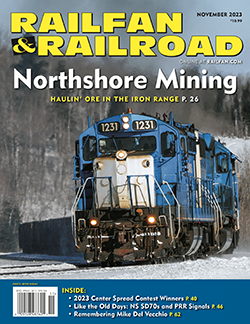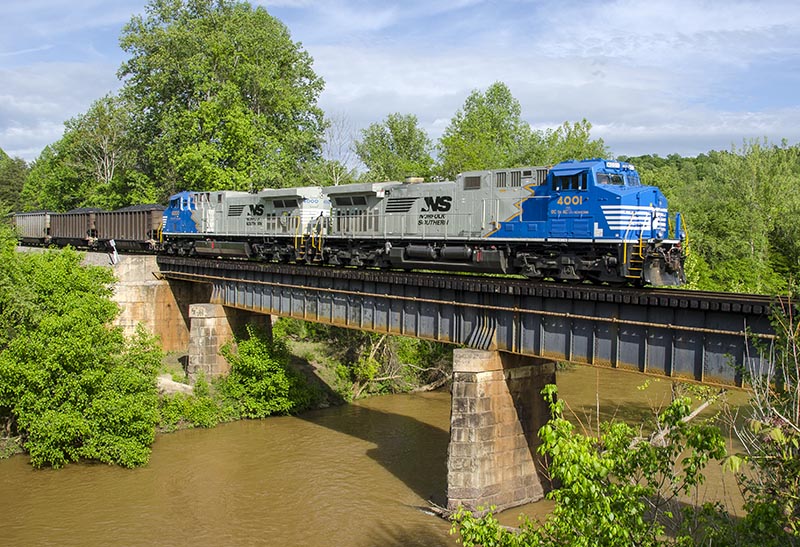 The number of new locomotives purchased by Class I railroads in the 2020s has plummeted to all-time lows. In fact, entire calendar years have gone by without a major freight railroad placing an order for a new locomotive. You might guess that this would make for a rapidly aging locomotive fleet, and you’d be right. What this obscures, however, is the rise in locomotive rebuilding, especially those projects completed in-house.
The number of new locomotives purchased by Class I railroads in the 2020s has plummeted to all-time lows. In fact, entire calendar years have gone by without a major freight railroad placing an order for a new locomotive. You might guess that this would make for a rapidly aging locomotive fleet, and you’d be right. What this obscures, however, is the rise in locomotive rebuilding, especially those projects completed in-house.
The outstanding example here is Norfolk Southern, whose Juniata Shops in Altoona, Pa., has turned out a wide variety of rebuilt locomotives in recent years, ranging from updates of 40-year-old EMD SD40-2 designs with new cabs and updated control systems, to an experimental battery-powered engine rebuilt from an old GP38, to an extensive reworking of 1980s diesels into low emissions “ECO”-series power.
This may seem like a break in tradition. Throughout the modern diesel era, most of the larger railroads have chosen to replace rather than rebuild older units. This created a vast secondhand market, with older engines becoming “hand-me-downs” for short lines, regionals, and leasing firms. However, this 21st century reliance on rebuilds is a return to tradition more than a break from it. Chicago & North Western was well known for its low-budget rebuilds, not to mention Santa Fe’s 1970s remanufacturing of 1940s streamliners. More pointedly, during the steam era, railways kept locomotives well in excess of 20 or 30 years, frequently rebuilding them to extend their service life. Indeed, Juniata Shops was originally built for precisely this purpose.
Why has the industry returned to this practice? Part of the answer, I think, is a lack of clarity about the future of motive power. Industry insiders are contemplating a drift away from conventional fossil fuels. In recent years, we’ve seen widespread discussion of the potential of battery-electric locomotives that would charge off the electrical grid when not in use. While the technology is not there just yet, Progress Rail (the successor to legendary EMD) is presently building four test units of this type for BNSF.
CSX and CPKC, meanwhile, are forming a partnership to construct (at CSX’s Huntington Shops) experimental hydrogen-powered locomotives — though several technical challenges remain before widespread use may become possible. The best and most obvious option is electrification; however, freight railways remain allergic to this idea, as it would involve an incredible amount of up-front infrastructure cost.
While the industry confronts both new technologies and hard choices, we’ll continue to see an aging locomotive fleet, and yet more rebuilt units. But is the locomotive even necessary? Some think not. VIA Rail’s recent purchase of Siemens self-propelled integrated Venture train sets for its Quebec City–Toronto–Windsor corridor is one example, harkening back to early streamliners like the Budd-built Zephyr of the 1930s and Budd’s later self-propelled diesel-mechanical Rail Diesel Car of the 1950s.
As for freight? In the 1990s, German engineering firm Windhoff produced the CargoSprinter for Deutsche Bahn. This consisted of five flatcars for container transport, while at each end was what appeared to be a cab-over semi truck, with power delivered by six Volvo 6-cylinder diesel engines. While the CargoSprinter in specific has thus far proved of limited use for freight — most have been converted to maintenance-of-way uses — the concept of a self-propelled freight car continues to evolve.
The most recent example is short line conglomerate Genesee & Wyoming, which announced a partnership with tech firm Parallel Systems to test out battery-powered autonomous freight cars. If successful, the future of freight rail may be missing locomotives entirely, as well as the skilled conductors and engineers who operate them.
—Alexander Benjamin Craghead is a transportation historian, photographer, artist, and author.



